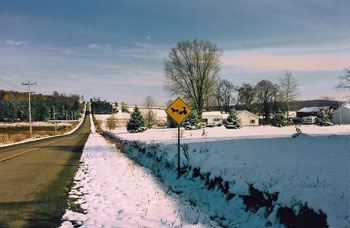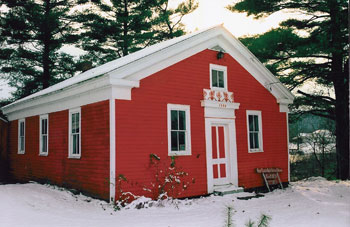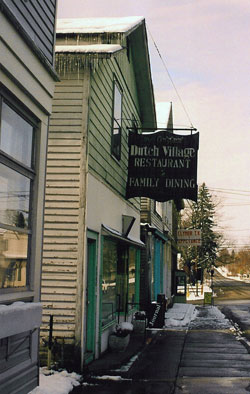Clymer is a predominantly Dutch village in the western part of New York State. Because it was relatively close to New York City, it became a popular destination for Dutch emigrants in the nineteenth century. Most of the early settlers came from the eastern part of Gelderland.
Settlement
Chautauqua County, the southwestern county of New York State, was founded in 1808. The village of Clymer was founded in this county in 1821. The town was named after George Clymer, an eminent Pennsylvanian and one of the signers of the declaration of independence.
The land in Chautauqua county was purchased by the Holland Land Company, that sold the land to immigrants. Many immigrants arrived in New York City and then travelled on to Albany with the intent to cross the Great Lakes. In Albany, they were approached by people from the Holland Land Company and interested in buying land in Chautauqua.

The Dutch settled in many villages in Chautauqua County, but most of them settled in Clymer. The first Dutch immigrants arrived there in 1844: the Lomans and Navis families from Winterswijk. In 1845, several more Winterswijk families followed. By 1851, about 25 Dutch families were living in Clymer. Most of them settled in the Northwestern part of the town. They settled on the old and the new “plank” roads, the “pork” road, and the town line road between Clymer and Sherman west from the plank road. The pork road was presumably called that because many of the Dutch kept pigs.
Over the next several decades, many more Dutch immigrants settled in Clymer or neighboring villages such as French Creek, Mina and Harmony. Most of them came from Winterswijk and Aalten in Gelderland, although some came from Overijssel, Groningen, Friesland and Zeeland.
Church life
In 1845, the Congregational denomination started working among the Dutch. As early as 1846, the church had its own Dutch minister (dominee), Adolph Hesselink from Aalten. He was known as a good preacher. He stayed in Clymer until 1850, when he moved to Muscatine, Iowa.
After his departure, the people in Clymer found Jan Willem Dunnewold from Winterswijk willing to come to them and study to be a minister. It was under his leadership that the church was received into the Reformed Church of America in 1853. Although he was not a great preacher as far as preaching from the pulpit went, he was an excellent pastor to his people. In 1868, he acceped a summons from Gibbsville, WI.
Rev. Dunnewold suggested another man from Winterswijk, Gerrit Jan Renskers, as his successor. The two men knew each other back in Winterswijk and had often had heated arguments about the Secession. Renskers had come to the US in 1846 and was a minister in Zeeland, MI, before coming to Clymer.
It is said that when two Dutchmen get together, they form a church but when three get together, the church is split. This was also true in Clymer. In 1869, eighteen members were given letters of dismissal from the Clymer Hill Church (the motherchurch). The Reformed Church of Clymer was founded.
Education
As early as 1853, a schoolhouse was established to teach the young. It was in use for 86 years. Remarkably, this ‘little red schoolhouse’ still exists today. It has been designated as a historic place in 1994.

Clymer today
The Dutch origins of Clymer can still be seen today. Many people in the telephone book have Dutch surnames.

Clymer emigrants
Dutch families that emigrated to Clymer and continue to live there include: Van Albeslo (Armslow), Arnink, Bekerink (Beckering), Bemers, Bensink, Blekkink (Blekking), Boland, Damkot (Damcott), Deunk (Duenk), Dunnewold (Dunnawold), Van Eerden (VanEerden), Einink, Grevink (Gravink), ten Haken (TenHaken), Harmelink, Hesselink, Hoitink/Hoijtink, Holthuis (Holthouse), Te Kempel (TeKempel), Te Kolste (TeKolste, TaKolste), Konings (King), Kortschot (Croscutt), Te Kronnie (TaKronnie), Lammers, Legters, Luikenhuis (Lookenhouse), Meerdink, Mensink, Navis, Nekkers (Neckers), Nijenhuis (Newhouse), Oonk, Priester, Reusselink (Reslink), Rikkers (Rickers), Rospas (Raspas), Schreurs (Schruers, Schruis), Slotboom, Vardink (Fardink), Warnshuis, Wiggers, Wilterdink, Te Winkel (TeWinkle, Te Winkle), Wubbels.
This site has stories about some of these Dutch families who settled in Clymer:
- Jan Willem Einink and Gesina Johanna te Brinke
- Garrit Hendrik Kolstee and Engelina Nijenhuis
- Gerharda Aleida (Dorcas) Nijenhuis
- Hermanus Piek and Johanna Catharina Bekerink
- Jan Hendrik Schreurs and Janna Geertruid Oonk
- Hendrik Jan Warnshuis family
- Jan Hendrik Warnshuis and Johanna Konings
Sources and further information
- Formation of the Towns of Chautauqua County
- Chautauqua County NYGENWEB website
- Clymer Cemetery records
- History of Clymer
- Little Red Schoolhouse
- Correspondence with Thelma Heil
- Willem Wilterdink: Winterswijkse pioniers in Amerika


My name is Beth Doreen Newsom, (TeWinkle). I am the daughter of Everett TeWinkle and Grand daughter of Freda and Walter TeWinkle. My Grand mother’s house sat on the corner of Main St. and Mohawk. Right across from the school. I see it has been torn down and that is a shame as it was one of the first homes built in Clymer and my Grandparents were some of the first settlers. The wood beams on the inside were worth a fortune and the basement was made of huge boulders and rocks. It should have been classified as a historical home and preserved by the village. I also see that the Windmill has been moved out to the edge of town. Shame! Where are the Tulips grown now and do you still have the “Tulip Festival” every year or has that stopped also? Please don’t let Clymer’s history die!
Hi Beth! My name is Anna Woods (my mother is a Lictus) and I currently live in Clymer. It was a shame about that house, it was beautiful but unfortunately not well taken care of near its end. One windmill has been moved from the island in the pond to that spot and it looks perfect there. I believe there are only two others (one on Route 474 just past Lictus Keystone and one on the corner of Clymer Corry Road and Knowlton Road). The Tulip Festival is held every other year and will be held May 2020! The dates are May 15 and 16 with Tulip Queen crowning Friday night and the main festival on Saturday.
Hi Beth! I’m an older Clymerite. 80 to be exact. I lived right next door to your Grandma Freda for 18 years, as I was married at 18 and moved to the farm that my Husband and his Dad bought and been here since 1959. I used to be in the house with your Grandma many times. She and my Mom were best friends. I used to play in the barn just back of your Grandma’s house. All that property was owned by Legters Bros.( that was my dad, his brother Harold and started by my Grandpa Legters and his brother Clifford Legters.) who ran the Meat market for 75 years. I’m trying to think who owned the house after your Grandma died. I was gone by then, but one of the girls names was Norma Jean. I helped many years with the Tulip Festival. Was Tulip Queen in 1957…Now my husband has Dementia. He cannot work the farm anymore. 2 of our sons (out of 3) and our oldest Grandson run the farm. The farm is just a mile out of Clymer going West. It used to be the Thompson farm. Its all different now. Maybe you will answer my commet…..
Beth, my Grandmother Flora (Crosscut) Eshelman was your Grandmother’s twin sister. My mother was Carol (Eshelman) Johnson. Loved hearing this and faintly remember the house you talk about
Beth. Oh my goodness. I can’t believe I just saw your name. This is Colleen Schurman Harrower. My daughter sent me a link to history of Clymer. Do you realize it’s been 50 years since we last talked? Hope you see this real soon (today is 12/29/22). Where are you? I’m still in Chautauqua County.
Who among you having lived in Clymer are Frisian descendants? I graduated from Sherman in 1951 but did not know then that my surname, Wykhof, is Frisian. Johnny White was a friend who invited me to his church in 1956 to show my slides from a trip to Holland. A neighbor, Art Stoddard, was the barber in Clymer for many years, having married Judy, a gal from Clymer.
Here is an interesting note on Dutch DNA: https://www.dutchgenealogy.nl/what-dutch-dna-looks-like-2020-edition/?fbclid=IwAR1PlQ1bhfB188torWC8JoP4Ik1GRrlXJa0zE4k5qqmXBVACnvWpdIVF_dc
My grandfather grew up in Clymer, his father was Floyd Arnink(Mildred Roberta Lines) who’s father was Albert J. Arnink(Florence Norton), Son of Gerrit Jan Arnink(Johanna Damkot) who immigrated from the Netherlands in 1866.
I am hoping to find other relatives and to know where they all ended up. On the 1920 and 1930 census’ there are many many Arninks listed, but now in 2021 there are only about 25 that I can find via the internet, living in the USA or Canada, 13 of which are directly related to me. I’d like to know how or if I am related to all of the other Arninks listed on the census and whether that goes back to the Netherlands, and if they are one family that immigrated slowly over time, or are many unrelated families with a common surname.
Any information is helpful
Hi everyone!
My name is Allison Murphy!
My grandmother’s made a name was Wilson and my grandfather’s name was Roraback.
As far as I know we don’t have any family and climber but my grandfather used to own the Dutch Village around the 1940s.
I didn’t know if anybody had remembered Bill and Lucille Roraback.
Hello, my great grandmother was Lola Newhouse. Her parents were Harry ives and Cena (Newhouse) Ives. She lived in North Eaat after getting married. My husband and I live in Clymer now and I am still learning more about my family. There is a lot of information about my family at the Findley Lake historical society as we descend from Alexander Findley but it’s nice to discover more, especially giving my children more knowledge of where we come from.
I don’t know what kind of genealogist you are but you forgot my Great Great Grandparents John Bernard Cy Wassink and his wife Christiana TeKronnie. My great-great-grandparents lived on Clymer Hill all their lives and helped build the Clymer Hill Church and also donated the land for the one-room schoolhouse. After their death, my Great grandparents lived in the same house until 1909 when they moved to Corry. I don’t appreciate your forgetting to mention the name Wassink they had a large family of 8 children that all lived most of their lives in Clymer.
You asked what kind of genealogist I am. I am the kind of genealogist who writes more than 1000 articles to help other people trace their Dutch ancestors, and makes them available for free. That’s who.
For the record, I said “the names include.” I did not suggest the list was complete. There were over 600 people from the Winterswijk area who went to Clymer so I did not name them all.
What kind of genealogist Yvette is: an amazingly gifted genealogist, board certified, and overly-qualified for anything she tackles. A blog post about an area is NOT an all-inclusive history of any one family or location. It’s an introduction to research in this area. Yvette is here to help and does so freely. Appreciation is what she deserves.
Wow, thank you, Cyndi!
Enjoyed reading about Clymer. I am working on a similar article about Terschelling and Ostfries immigrants to Stephenson County, Illinois.